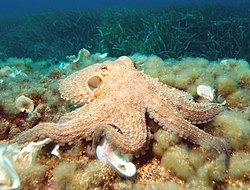
Back Seekat Afrikaans Solita AMI أخطبوطيات Arabic زايز ARY اخطبوط ARZ Octopoda AST Səkkizayaqlılar Azerbaijani اوْسمینوقلار AZB Grita BAN Kugita BCL
| Octopus Temporal range:
| |
|---|---|

| |
| Common octopus (Octopus vulgaris) | |
| Scientific classification | |
| Domain: | Eukaryota |
| Kingdom: | Animalia |
| Phylum: | Mollusca |
| Class: | Cephalopoda |
| (unranked): | Neocoleoidea |
| Clade: | Vampyropoda |
| Superorder: | Octopodiformes |
| Order: | Octopoda Leach, 1818[1] |
| Suborders | |
|
(traditional) See § Evolution for families | |
| Synonyms | |
| |
An octopus (pl.: octopuses or octopodes[a]) is a soft-bodied, eight-limbed mollusc of the order Octopoda (/ɒkˈtɒpədə/, ok-TOP-ə-də[3]). The order consists of some 300 species and is grouped within the class Cephalopoda with squids, cuttlefish, and nautiloids. Like other cephalopods, an octopus is bilaterally symmetric with two eyes and a beaked mouth at the centre point of the eight limbs.[b] An octopus can radically deform its shape, enabling it to squeeze through small gaps. They trail their appendages behind them as they swim. The siphon is used for respiration and locomotion (by water jet propulsion). Octopuses have a complex nervous system and excellent sight, and are among the most intelligent and behaviourally diverse invertebrates.
Octopuses inhabit various ocean habitats, including coral reefs, pelagic waters, and the seabed; some live in the intertidal zone and others at abyssal depths. Most species grow quickly, mature early, and are short-lived. In most species, the male uses a specially-adapted arm to deliver sperm directly into the female's mantle cavity, after which he becomes senescent and dies, while the female deposits fertilised eggs in a den and cares for them until they hatch, after which she also dies. Strategies to defend themselves against predators include expelling ink, camouflage, and threat displays, the ability to jet quickly through the water and hide, and deceit. All octopuses are venomous, but only the blue-ringed octopuses are known to be deadly to humans.
Octopuses appear in mythology as sea monsters such as the kraken of Norway and the Akkorokamui of the Ainu, and possibly the Gorgon of ancient Greece. A battle with an octopus appears in Victor Hugo's book Toilers of the Sea. Octopuses appear in Japanese shunga erotic art. They are eaten and considered a delicacy by humans in many parts of the world, especially the Mediterranean and Asia.
- ^ "ITIS Report: Octopoda Leach, 1818". Itis.gov. 10 April 2013. Retrieved 4 February 2014.
- ^ "Coleoidea – Recent cephalopods". Mikko's Phylogeny Archive.
- ^ "Octopoda". Merriam-Webster.com Dictionary. Merriam-Webster. Retrieved 12 July 2021.
- ^ Scully, Caitlin (11 October 2018). "Get to Know th Four Types of Cephalopod". Birch Aquarium Blog. U CSan Diego.
Cite error: There are <ref group=lower-alpha> tags or {{efn}} templates on this page, but the references will not show without a {{reflist|group=lower-alpha}} template or {{notelist}} template (see the help page).
© MMXXIII Rich X Search. We shall prevail. All rights reserved. Rich X Search